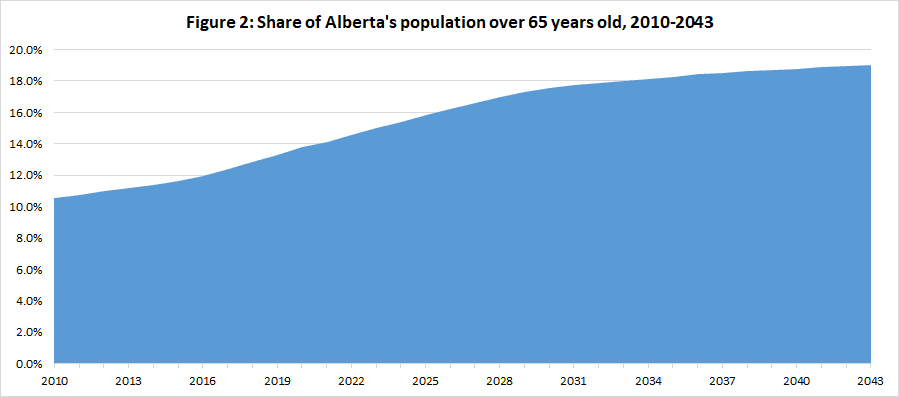Alberta’s fiscal challenges will continue post-pandemic

The pandemic delivered a serious blow to Alberta’s finances, contributing to a $17.0 billion budget deficit during the height of COVID in 2020/21. Unfortunately, the province’s fiscal challenges won’t stop after the pandemic is over. Indeed, Alberta’s population is aging and that comes with significant negative consequences.
Alberta’s fertility rate—and relatedly, population growth—is expected to decline in the coming decades. At the same time, Albertans are living longer. A slower population growth rate coupled with increasing life expectancy means seniors will constitute a greater share of Alberta’s population in the future than they do today.

The above chart helps illustrate Alberta’s aging population. In 2020, Albertans aged 65 or older accounted for 13.8 per cent of the total population. According to projections, that proportion will reach 18.8 per cent by 2040. This will slow growth in government revenue and drive increases in health-care spending.
Let’s start with the revenue side. The working-age (15 to 64) share of Alberta’s population is projected to decline from 67.6 per cent in 2020 to 64.8 per cent by 2040. Unless there’s a marked increase in senior’s participation in the workforce, this will likely mean a marked decline in the share of Albertans that are working, driving economic growth and generating tax revenue.
At the same time, seniors use more health-care resources than other age groups, which will put pressure on health-care spending. Albertans aged 65 or older accounted for 36.9 per cent of all provincial health-care spending in 2018 despite accounting for only approximately 12.8 per cent of the provincial population. In contrast, Albertans under the age of 25 accounted for just 17.7 per cent of all provincial health-care spending while constituting a much larger share (31.1 per cent) of the population.
Correspondingly, health-care spending is projected to increase by approximately 5.6 per cent annually (on average) from now until 2040. Put differently, this area of spending is projected to increase from 6.3 per cent of the provincial economy in 2019 to 7.0 per cent of the economy by 2040.
According to recent projections, Alberta’s aging population will put significant pressure on its provincial finances. In fact, the province will likely not see a balanced budget until at least 2040 absent a change in policy. The risk of future recessions, rising interest rates and other unexpected events will only compound problems further.
Alberta’s fiscal challenges won’t go away with the pandemic. Fortunately, these projections are not set in stone. The provincial government can improve Alberta’s fiscal outlook by making policy changes today, including controlling government spending.
Authors:
Subscribe to the Fraser Institute
Get the latest news from the Fraser Institute on the latest research studies, news and events.

